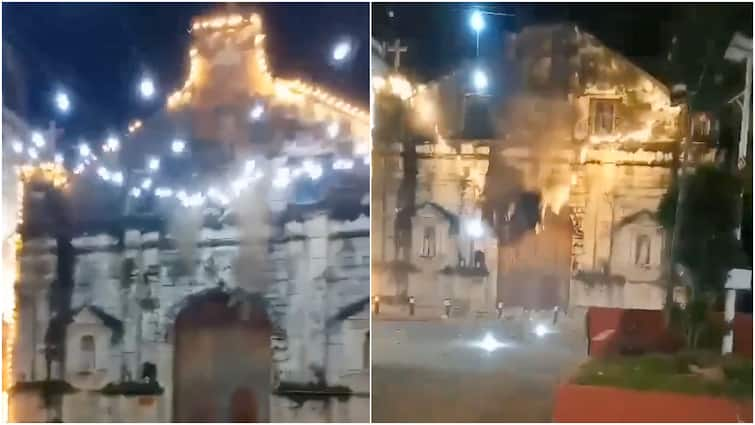A powerful 6.9-magnitude earthquake struck central Philippines on Tuesday, causing partial collapse of the centuries-old Parish of Saint Peter the Apostle in Bantayan, Cebu. Videos of the heritage church crumbling, with its outer façade falling and lights toppling, have been widely shared across social media platforms.
⚡️Powerful M6.9 Earthquake Rocks Philippines 🇵🇭 – Tremors Knockout Lights at Church on Bantayan Island pic.twitter.com/TtVxqJH0V3
— RT_India (@RT_India_news) September 30, 2025
Martham Pacilan, a 25-year-old resident of Bantayan, described the terrifying moment, telling AFP, “I heard a loud booming noise from the direction of the church, then I saw rocks falling from the structure. Luckily no one got hurt. I was in shock and in panic at the same time, but my body couldn’t move; I was just there waiting for the shake to stop.”
Residents Warned of Minor Sea-Level Disturbance
The Philippine Institute of Volcanology and Seismology (PHIVOLCS) advised residents on the central islands of Leyte, Cebu, and Biliran to “stay away from the beach and not to go to the coast” due to a potential minor sea-level disturbance. However, the Pacific Tsunami Warning Centre confirmed that there is no tsunami threat from the earthquake and stated that “no action is required”.
The quake’s epicentre was recorded around 11 kilometres (seven miles) east-southeast of Calape in Bohol province, which has a population of 33,000.
Damage Across Cebu, Rescue Efforts Underway
The earthquake caused widespread disruption, damaging buildings and roads, while knocking out power in several areas. Municipal workers inspected a collapsed public building and a gym in northern Cebu hours after the tremor struck at 9:59 pm local time (1359 GMT), according to provincial rescue official Wilson Ramos, who told AFP, “There could be people trapped beneath collapsed buildings,” referring to ongoing rescue operations in San Remigio and Bogo.
Recovery efforts have been complicated by darkness and aftershocks, with the US Geological Service recording four tremors of magnitude 5.0 or higher in the region following the main quake.
Cebu firefighter Joey Leeguid recounted the intensity of the tremor from San Fernando, stating, “We felt the shake here in our station, it was so strong. We saw our locker moving from left to right, we felt slightly dizzy for a while but we are all fine now.”
Residents have reported cracked tiles and structural damage in homes. Agnes Merza, a 65-year-old carer from Bantayan, said, “It felt as though we would all fall down. It’s the first time I have experienced it. The neighbours all ran out of their homes. My two teenage assistants hid under a table because that’s what they were taught in the boy scouts.”
Officials Urge Caution Amid Ongoing Seismic Activity
The Cebu provincial government reported the collapse of a commercial building and a school in Bantayan, in addition to damage on several village roads. Power outages were widespread as electricity lines tripped, with the National Grid Corp. of the Philippines assessing the full extent of the damage.
In a live Facebook address, Cebu provincial governor Pamela Baricuatro advised residents to “stay calm and move to open areas; keep away from walls or structures that may collapse and stay alert for aftershocks.”
Earthquakes are frequent in the Philippines, part of the Pacific “Ring of Fire”, a seismically active region stretching from Japan through Southeast Asia across the Pacific basin. While most tremors are minor, strong quakes occur unpredictably, and no technology can accurately forecast when or where they will strike.



